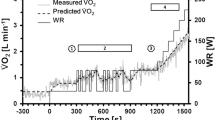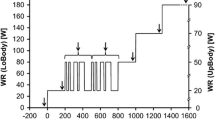Summary
The aim of this study was to assess the discriminatory power of the new reference system, power-duration product (PDP), for the analysis of haemodynamic and metabolic variables derived from cardiopulmonary exercise tests. The PDP was calculated as the cumulative index of the product of power (W) times the duration (minutes) of each individual exercise step. The study comprised 30 healthy male volunteers, who were classified into three groups with respect to their regular physical activity: 10 untrained medical students (students), 10 sprinters and long-jumpers (athletes) and 10 endurance athletes performing triathlon (triathletes). Twenty metabolic and haemodynamic variables were recorded throughout exhaustion-limited cycling ergometry. The data were analysed with respect to five reference systems (heart rate, relative and absolute oxygen consumption/body surface area, power, and PDP). A total of 14 differences between modified time courses of haemodynamic and metabolic variables in the three groups of volunteers were observed by reference to PDP, 12 by reference to relative oxygen consumption/body surface area, 11 by reference to heart rate, 8 by reference to absolute oxygen consumption/body surface area, and 7 by reference to power. When using PDP as the reference, the time courses of 8 parameters differed significantly between students and triathletes, 5 between students and athletes, and 1 between athletes and triathletes. In addition to its discriminatory superiority for the comparison of different groups characterized by different cardiopulmonary training and endurance, it was found that PDP permitted a better characterization of the individually performed exercise than the consideration of power per se.
Similar content being viewed by others
References
Alt FB (1982) Bonferroni t-Statistic. In: Kotz S, Johnson NL (eds) Encyclopedia of Statistical Sciences, vol 1. Wiley, New York, pp 300–301
Bachl N (1981) Möglichkeiten zur Bestimmung individueller Ausdauerleistungsgrenzen anhand spiroergometrischer Parameter. Oesterr J Sportmed [Suppl l] 11: 1–79
BMDP-83 (1983) Biomedical computer programs p-series. University of California Press, Berkeley
Borg GAV (1982) Psychophysical bases of perceived exertion. Med Sci Sports Exerc 14: 377–381
Frizzera S, Bertoli P, Resnyak S, Widmann K (1991) Triathlon: herkömmliche und neue Aspekte in der Funktionsdiagnostik. Dtsch Z Sportmed 42: 352–358
Jones NL, Campbell EJM (1982) Clinical exercise testing, 2nd edn. Saunders, Philadelphia, pp 81–84
Kaltenbach M, Kober G (1988) Auf welche Körperdimensionen sollten kardiozirkulatorische Meßwerte bezogen werden? Dtsch Med Wochenschr 113: 1932–1934
Löllgen H (1983) Kardiopulmonale Funktionsdiagnostik. Ciba, Wehr/Baden, p 190
Löllgen H, Ulmer H-V, Crean P (1988) Recommendations and standard guidelines for exercise testing: a report of the Task Force Conference on Ergometry. Eur Heart J 9 [Suppl K]: 3–37
Mellerowicz H (1979) Ergometrie, Grundriß der medizinischen Leistungsmessung, 3rd edn. Urban and Schwarzenberg, Munich, p 201
Mellerowicz H (1983) Der heutige Stand der Ergometrie. Med Klin 78: 250–255
Meyer-Erkelenz JD, Mösges RW, Sieverts H (1980) Spiroergometrie (kardiopulmonale Funktion unter Belastung). Prax Pneumol 34: 585–600
Niederberger M (1982) Belastungsuntersuchungen in der Kardiologie. Prinzipien der Ergometrie. Herz 7: 1–28
Niederman MS, Henderson Clemente P, Fein AM, Feinsilver SH, Robinson DA, Ilowite JS, Bernstein MG (1991) Benefits of a multidisciplinary pulmonary rehabilitation program. Chest 99: 798–804
Schlant RC, Blomquist CG, Brandenburg RO, DeBush R, Ellestad MH, Fletcher GF, Froelicher VF, Hall RJ, McCallister BD, McHenry PL, Ryan TL, Sheffield LT (1986) Guidelines for exercise testing. Circulation 74: 653A-667A
Sue DY, Wasserman K (1991) Impact of integrative cardiopulmonary exercise testing on clinical decision making. Chest 99: 981–992
Takano N (1988) Effects of pedal rate on respiratory responses to incremental bicycle work. J Physiol 396: 389–397
Wasserman K, Hansen JE, Sue DY, Whipp BJ (1987) Principles of exercise testing and interpretation. Lea and Febiger, Philadelphia, pp 62–71
Weber KT, Janicki JS (1985) Cardiopulmonary exercise testing for evaluation of chronic cardiac failure. Am J Cardiol 55: 22A-31A
Author information
Authors and Affiliations
Rights and permissions
About this article
Cite this article
Breuer, HW.M., Pfeiffer, U., Worth, H. et al. The power-duration product — evaluation of a new reference system for cardiopulmonary exercise testing. Europ. J. Appl. Physiol. 65, 118–123 (1992). https://doi.org/10.1007/BF00705067
Accepted:
Issue Date:
DOI: https://doi.org/10.1007/BF00705067




